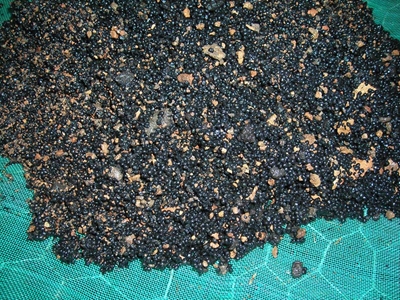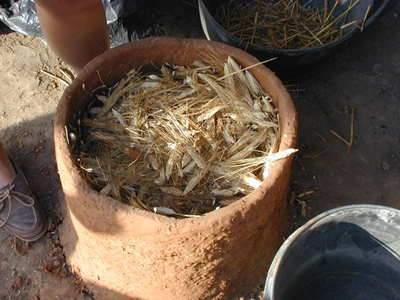Archaeobotanical investigations
 Excavation of the prehistoric levels has unearthed a considerable quantity of charred plant remains, including wood charcoal used as building material or fuel, and grains and fruits brought to the site for food or for other purposes (e.g. medicines, fuel, building, or weaving material). More or less systematic collection of plant remains has been on-going since 1989, and today intensive total sampling is employed in certain parts of the excavation, as is the case of House 1. Charcoal and other plant macroremains provide a precious source of information on the past environment surrounding the site, agricultural practices, diet, and building practices (as when plants were added to the building clay). At the same time, these remains provide excellent samples for radiocarbon dating : at present, more than forty dates have been obtained from such remains just in the Neolithic. Some of these dates, obtained from grains found in situ inside the houses, reach a precision of ± 20 years, dating the destruction of the houses to within a few decades.
Excavation of the prehistoric levels has unearthed a considerable quantity of charred plant remains, including wood charcoal used as building material or fuel, and grains and fruits brought to the site for food or for other purposes (e.g. medicines, fuel, building, or weaving material). More or less systematic collection of plant remains has been on-going since 1989, and today intensive total sampling is employed in certain parts of the excavation, as is the case of House 1. Charcoal and other plant macroremains provide a precious source of information on the past environment surrounding the site, agricultural practices, diet, and building practices (as when plants were added to the building clay). At the same time, these remains provide excellent samples for radiocarbon dating : at present, more than forty dates have been obtained from such remains just in the Neolithic. Some of these dates, obtained from grains found in situ inside the houses, reach a precision of ± 20 years, dating the destruction of the houses to within a few decades.
 The anthracological study shows a rich variety within the forest canopy near the site and reveals, among other things, an intensive use of fruit trees (e.g. apples, pears, plums, and figs) by the site’s inhabitants already during the Neolithic. The archaeobotanical study confirms that most of these trees were exploited for their fruits, which could have been consumed on their own or included as meal ingredients. The primary plant foods during the Neolithic and the Bronze Age were cereals and legumes, as is the case throughout the Aegean during these periods. Different wheat species, barley, lentils, peas, and bitter vetch are the main crops attested at Dikili Tash.
The anthracological study shows a rich variety within the forest canopy near the site and reveals, among other things, an intensive use of fruit trees (e.g. apples, pears, plums, and figs) by the site’s inhabitants already during the Neolithic. The archaeobotanical study confirms that most of these trees were exploited for their fruits, which could have been consumed on their own or included as meal ingredients. The primary plant foods during the Neolithic and the Bronze Age were cereals and legumes, as is the case throughout the Aegean during these periods. Different wheat species, barley, lentils, peas, and bitter vetch are the main crops attested at Dikili Tash.
They are often found as pure concentrations, unmixed with other species stored in vases or bins located inside the houses or in the yard outside. Other plant species also appear in the Neolithic period, two of which go on to an illustrious future : flax and grape vine.

